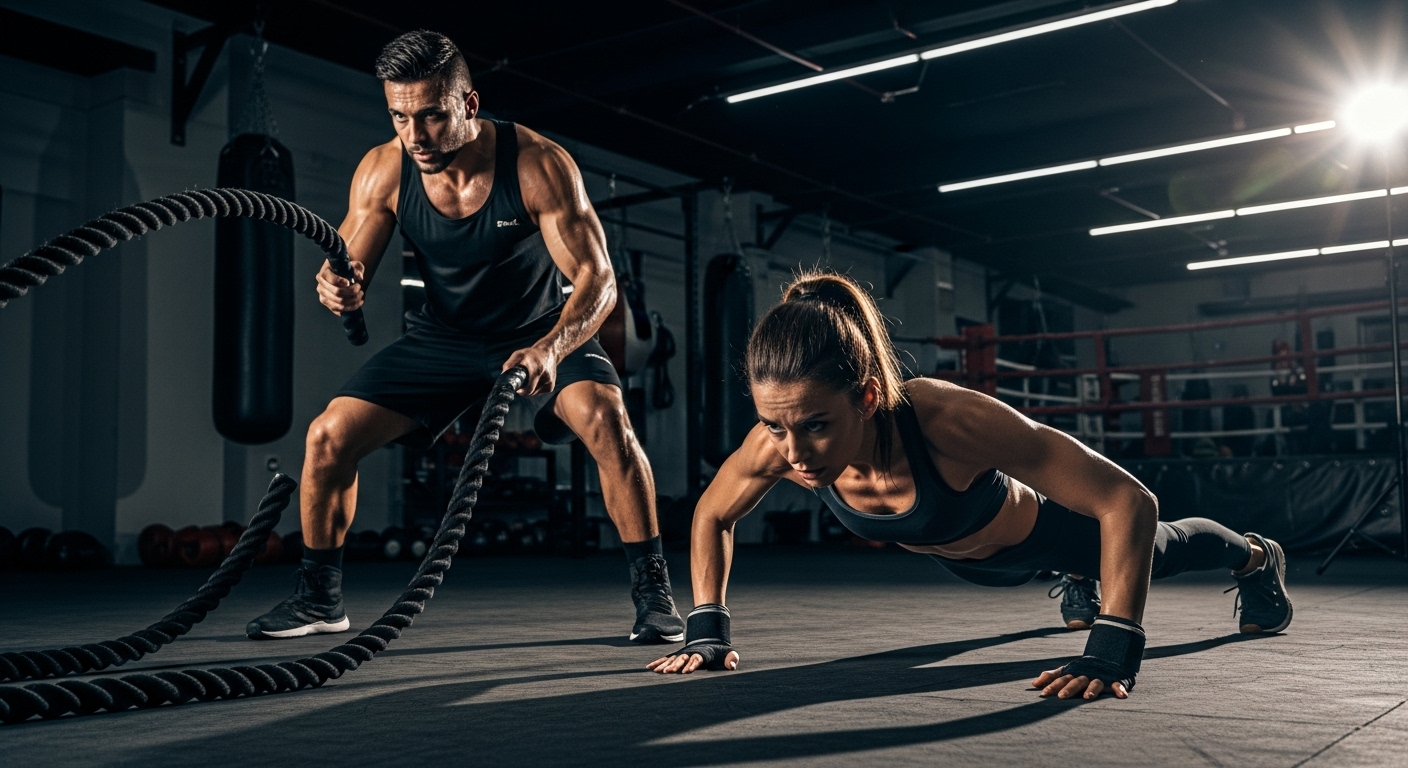Are you a boxer looking to enhance your performance in the ring? Do you wonder if there’s a way to improve your endurance, strength, and agility all at once?
We believe a well-structured full-body strength and conditioning circuit is key. By adding a complete training program to your boxing routine, you can see big improvements. This will help you perform better overall.
Our circuit is tough, aiming to boost your endurance, strength, and agility. It’s a vital part of effective Boxing workouts. It makes you a stronger opponent.
Key Takeaways
- Improve your endurance, strength, and agility with a full-body strength and conditioning circuit.
- Enhance your overall boxing performance with a complete training program.
- Increase your muscular endurance and strength.
- Become a more agile and formidable opponent in the ring.
- Achieve your boxing goals with a well-structured training regimen.
Why Strength and Conditioning Matters for Boxing Performance
Boxers know that strength and conditioning are key for top performance. A good strength and conditioning program helps us throw strong punches and take punches well. It also lets us keep up a high pace during fights.
Joining boxing fitness classes that focus on strength and conditioning can really boost a boxer’s game. These classes mix strength training, cardio, and boxing drills. They’re all about getting better at boxing.
The Science Behind Boxing-Specific Conditioning
Boxing-specific conditioning is based on science. It aims to boost muscular endurance, power, and heart health. Cardio boxing exercises mimic the intense effort of a fight. They help the boxer’s heart and lungs get ready for the sport.
Benefits Beyond the Ring
Strength and conditioning do more than just improve ring performance. They also boost overall fitness and health. Plus, the discipline and confidence gained can positively affect other parts of a boxer’s life.
Essential Boxing Workouts for Complete Athletic Development
Boxing needs a mix of strength, power, and endurance. A good training plan is key for success. Boxers must do different workouts to get it right.
Balancing Strength, Power, and Endurance
A good boxing workout should boost strength, power, and endurance. Strength training makes punches stronger and defense better. Power exercises, like plyometrics, make movements explosive.
Endurance training, like running and HIIT, keeps boxers going in fights. At-home boxing routines with bodyweight exercises are great for building endurance and strength.

Functional Movement Patterns for Boxers
Boxing needs specific movements that require functional training. Boxing drills that match fight movements are key. Exercises like medicine ball throws and rotational movements boost power and speed.
Agility drills and footwork exercises make boxers more athletic and mobile in the ring. Focusing on balanced athletic development and functional movements improves ring performance.
Preparing for Your Circuit: Warm-Up and Equipment
A good boxing training regimen begins with a proper warm-up and the right gear. This sets the stage for a successful workout. Let’s look at how to get ready.
Dynamic Warm-Up Protocol
A dynamic warm-up is key to get your muscles and heart ready for the workout. It should include movements that match what you’ll do in your boxing training regimen.
- Leg swings to loosen the hips and legs
- Arm circles to warm up the shoulders
- High knees and butt kicks to get your heart rate up and prepare your lower body
This warm-up reduces injury risk and boosts performance. It increases blood flow and muscle temperature.

Equipment Options for Home and Gym
The right gear is vital for your boxing training regimen. Home or gym, you’ll need specific equipment. At home, get a good punching bag, resistance bands, and a jump rope. Gyms offer treadmills, weight machines, and heavy bags.
Choose equipment based on durability, safety, and your training focus. For strength training, dumbbells or kettlebells are great.
The Complete Boxing Circuit Breakdown
To improve your boxing skills, add a structured strength and conditioning circuit to your training. This approach boosts strength, endurance, and agility for better performance in the ring.
Upper Body Power and Endurance
Boxers need strong upper bodies for powerful punches and defense. We focus on exercises that boost both power and endurance.
Push Exercises: Medicine Ball Throws, Plyometric Push-ups
Medicine ball throws are great for explosive power. Stand with your feet apart, hold the ball at chest level, and throw it forward. Use your legs and core for power. Plyometric push-ups also work well, requiring quick, powerful movements.
Pull Exercises: Resistance Band Rows, TRX Face Pulls
Pull exercises are key for a balanced upper body. Resistance band rows work the back and arms. TRX face pulls strengthen shoulders and improve defense.
Core and Rotational Power Development
A strong core is vital for a boxer’s power and stability. We’ll do exercises that strengthen the core and improve rotational power.
Anti-Rotation Exercises: Pallof Press, Renegade Rows
Exercises like Pallof press and renegade rows boost core stability. They help boxers keep their posture and punch power.
Explosive Core Movements: Russian Twists, Medicine Ball Slams
Movements like Russian twists and medicine ball slams enhance rotational power. They mimic boxing’s dynamic movements, improving performance.
Lower Body Strength and Explosiveness
Lower body strength is key for boxing power and stability. We’ll focus on exercises that build strength and explosiveness.
Foundational Strength: Split Squats, Deadlifts
Split squats and deadlifts are essential for lower body strength. They improve stability, balance, and power.
Plyometric Power: Box Jumps, Lateral Bounds
Plyometric exercises like box jumps and lateral bounds boost explosiveness. They help boxers quickly generate force and change direction.
| Exercise | Sets | Reps | Rest |
|---|---|---|---|
| Medicine Ball Throws | 3 | 10 | 60s |
| Plyometric Push-ups | 3 | 15 | 90s |
| Resistance Band Rows | 3 | 12 | 60s |
| TRX Face Pulls | 3 | 12 | 60s |
Boxing-Specific Conditioning Finishers
To end our circuit, we’ll add conditioning exercises that mimic boxing. This includes heavy bag workouts and shadow boxing techniques.
Heavy Bag Interval Protocols
Heavy bag workouts improve endurance and technique. We’ll use interval protocols to make these workouts more effective.
Shadow Boxing Endurance Drills
Shadow boxing enhances hand-eye coordination, footwork, and endurance. Adding endurance drills to our shadow boxing routine boosts our ring performance.
Implementing the Circuit: Schedules and Common Mistakes
To get the most out of our boxing workouts, we need to do them right. A good training plan is key to our success.
Weekly Training Structure for Different Experience Levels
Our weekly training plan should match our skill level. Beginners should start with 2-3 days a week. This helps build strength and endurance.
As we get better, we can do more. Intermediate boxers can aim for 3-4 days a week. They’ll do more complex exercises and harder intervals.
Advanced boxers train 4-5 days a week. They focus on perfecting their skills and getting in top shape.
| Experience Level | Training Days per Week | Focus |
|---|---|---|
| Beginner | 2-3 | Building foundation |
| Intermediate | 3-4 | Increasing intensity |
| Advanced | 4-5 | Fine-tuning skills |
Periodization for Fight Preparation
When we’re getting ready for a fight, our training gets more focused and intense. Periodization helps us peak on fight day.
“Periodization is the process of alternating periods of intense training with periods of rest and recovery. This allows the body to adapt to the demands of training and peak at the right time.”
For fight prep, we follow a 12-week plan. The training gets harder as the fight gets closer.
Avoiding Common Training Errors
Even with a good plan, we can make mistakes. One big error is overreaching. This happens when we push too hard without resting enough.
- Insufficient warm-up and cool-down
- Poor nutrition and hydration
- Inconsistent training
Knowing these common mistakes helps us avoid them. This way, our training stays effective and safe.
Conclusion: Taking Your Boxing Performance to the Next Level
We’ve looked at the key parts of a workout plan for boxers. It’s designed to boost their performance in the ring.
This plan includes exercises for upper body strength, core power, and lower body explosiveness. It also includes boxing-specific drills. This helps boxers become well-rounded athletes.
Joining Boxing fitness classes that use these methods can improve a boxer’s fitness and skills. It makes them more competitive.
As we keep improving boxing training, it’s clear that a complete approach is essential. It helps boxers reach their full abilities.
